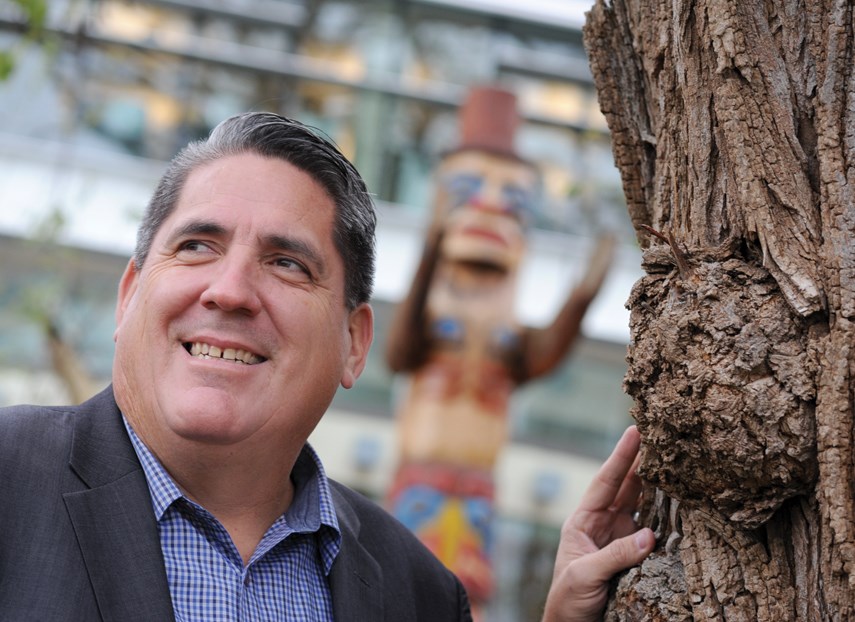Dr. Brad Baker

Brad Baker is a member of the Squamish Nation and has been an educator for 26 years (MILLER 2021). He is currently a District Principal in the North Vancouver School District (MILLER 2021). He is also a national leader in Indigenous Education, a recipient of an Indspire Indigenous Education Leadership Award and a member of the Governor General of Canada’s Leadership Group. His strong passion for teaching the Indigenous perspective in the education system involves creating an environment where Indigenous students are supported, and teachers are provided with resources to educate others (Seyd, 2021). Brad oversees the Indigenous education and safe and caring school programs and is situated on the anti-racism committee (MILLER, 2021).
How does a PLN help and hinder the development of thoughts and ideas in education discourse?
A PLN helps the development of thoughts and ideas in education because there are many connections between a student and a teachers PLN. This opens many opportunities for lifelong learning. For educators, they have colleagues, professional organizations, workshops, and conference events where they can network and share and listen to other ideas. In the same way, a students PLN can lead to the development of ideas, such as career opportunities, professional connections, and learning. In addition, having a PLN has helped allow Indigenous voices regarding truth and reconciliation to be released from an authentic source (MILLER, 2021). Having an authentic source has been more beneficial than mainstream media because mainstream media only shares what they want (MILLER, 2021). Although, a PLN has hindered the development of thoughts and ideas because it is limited to our PLN. Essentially, the information is passed down from one individual to the next, but not as quickly as it would on social media. It also lowers opportunities to extend to individuals outside of ones PLN.
How do educators create discourse?
Educators create discourse by including activities and discussions that actively involve students in the learning process. In a traditional classroom, students would participate in structured group discussions, games, assignments, research papers, or tests that allow them to share ideas. However, now many courses are using digital platforms for students to stay engaged in the course. Examples include online discussions, messaging apps, or educational activities like Kahoot.
What is the role of social media in education?
The role of social media in education allows students and teachers to interact online. It gives students a platform to communicate with teachers, other students, and course material (Perry & Edwards, 2009). A student creates a social presence through these interactions, also known as a “culture of community” (Perry & Edwards, 2009). In this online community, students listen and share their values, norms, and beliefs (Perry & Edwards, 2009). For instance, Microsoft Teams is an excellent platform for students to stay engaged with others in their online classes and stay up-to-date with assignments. Similarly, in this class, the professor posts weekly tasks for students to complete while using MatterMost to communicate with the professor and other students. Outside of the virtual classroom, social media plays a significant role in educating people worldwide. Brad Baker mentioned that social media websites like Twitter have opened more conversations for Indigenous communities (MILLER 2021). He has been able to educate others about his family story and become a positive contributor to society (MILLER, 2021).
What are some problems with social media communications in education settings?
The problem with social media communication in an educational setting is the lack of face-to-face communication that would normally be achieved in a traditional classroom. As Perry and Edwards (2009) states, an important part of online education is reducing the social distance by mimicking proximity through a social presence. One way to achieve a social presence in an online class is by having students demonstrate their participation from the beginning to the end of the course (Perry & Edwards, 2009). For example, in this course, having weekly blog posts, readings, and videos to watch keeps students engaged. Another problem is that students may not feel as motivated if they think it takes too much time and effort to participate (Perry & Edwards, 2009). This problem can be reduced by having a structured course and options for students to speak with professors, such as on Zoom or Microsoft Teams.
References
MILLER. (2021, June 10). Brad Baker EDCI 338 [Video]. YouTube. https://www.youtube.com/watch?v=C5z8iHxW2n4
Perry, B., & Edwards, M. (2009). Creating a culture or community in the online classroom using artistic pedagogical technologies. In T. Anderson & G. Veletsianos (Eds.), Emerging Technologies in Distance Learning (109-142). Athabasca University Press. https://www.aupress.ca/app/uploads/120177_99Z_Veletsianos_2010-Emerging_Technologies_in_Distance_Education.pdf
Seyd, J. (2021). North Van district principal to take on provincial role in Indigenous education. North Shore News. https://www.nsnews.com/local-news/north-van-district-principal-to-take-on-provincial-role-in-indigenous-education-4800556

picpen October 17, 2022
Hi Nat,
I saw you mentioned that many courses are now using digital platforms to keep students engaged in the course. But the fact that there are many people who are much more engaged in the traditional classroom than the digital platform, how do you thought about that?
Pen
nataly October 17, 2022 — Post author
Hi Pen. I think it is great that many teachers are offering courses online because of the easy accessibility for students. I mentioned the downsides of using social media in the classroom, but I also think the pandemic helped many students understand how to learn effectively online. Students experienced the transition from the traditional classroom to online. This transition made it easier for me to learn what works best for my learning in online courses, which I had not known before the pandemic. What are some ways that you find help you learn online?
stenpetey October 17, 2022
Hey,
I think you made a great point about how social media tools like Mattermost and Microsoft Teams help connect everyone in one place. I can relate to this as over the pandemic I was able to really learn how to use Teams and make the most out of the platform. This was one positive of the pandemic for me because it showed me how I can connect with others in an education setting without being present. I think that these two sites are great for educational use and its a shame that they are just starting to get traction now! Are these sites new to you? I wish I had access to these when I was going through High School.
nataly October 17, 2022 — Post author
Hi Stenpetey. Thanks for the response! 🙂 I did not have access to these websites in high school. I had heard about Microsoft Teams, but none of my high school courses ever used it. I see it now being used more in jobs and in courses. It would be great if students had access to this platform in high school to prepare them to use it in future education and careers. It could be used for group projects where students can connect with their classmates outside the classroom.